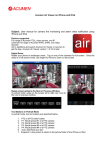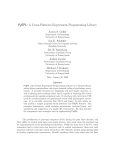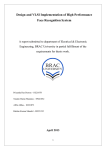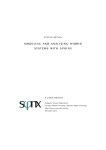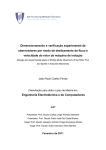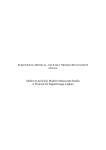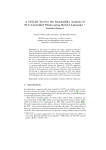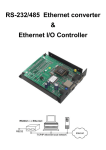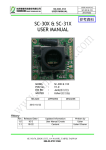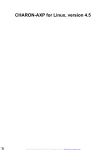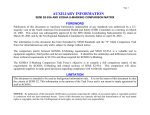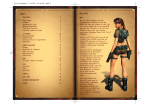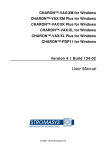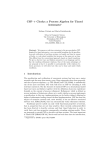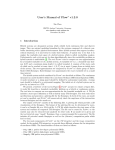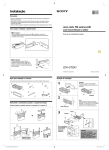Download A Core Language for Executable Models of Cyber
Transcript
A Core Language for Executable Models of Cyber Physical Systems
(Work In Progress Report)
Walid Taha
Paul Brauner and Robert Cartwright
Halmstad University, Halmstad, Sweden
Rice University, Houston, TX, USA
Walid.Taha@hh.se
Rice University, Houston, TX, USA
{polux2000, corky.cartwright}@gmail.com
Veronica Gaspes
Aaron Ames
Halmstad University, Halmstad, Sweden
Veronica.Gaspes@hh.se
University of Texas A&M, College Station, TX, USA
aames@tamu.edu
Alexandre Chapoutot
ENSTA ParisTech, Paris, France
alexandre.chapoutot@ensta-paristech.fr
Abstract— Recently it was shown that an expressive class of
mathematical equations can be automatically translated into
simulation codes. Focusing on the expressivity of equations on
continuous functions, this work considered only minimal
interaction with discrete behaviors and only a static number of
statically connected components. However, the interaction
between continuous and hybrid components in many cyber
physical domains is highly coupled, and such systems are often
highly dynamic in both respects. This paper gives an overview
of a proposed core language for capturing executable hybrid
models of highly dynamic cyber physical systems.
Keywords- Modeling, Simulation, Cyber-Physical Systems.
I.
INTRODUCTION
Systems that evolve over a dense notion of time interact
in complex ways that can confound both intuition and
analytical methods [11, 12]. This problem is acute for nonlinear differential systems, which include virtually all threedimensional mechanical systems, and for which solutions
rarely have closed form descriptions [13]. As a result,
successful analysis and design of novel cyber physical
systems invariably includes an extensive experimental
component that relies either on physical prototypes or on
simulation. Today, both types of experimentation can be
prohibitively costly and slow. Physical experiments incur
material costs and pose challenges in control and
reproducibility, measurement and instrumentation, and
safety. Simulation has the potential to reduce these problems
and to significantly accelerate innovation. But current
methods either raise questions about fidelity or are extremely
labor intensive. Using mainstream tools means depending
on proprietary, black-box codes that come with a fixed set of
component models and that offer only limited support for
building custom models. Writing simulation codes by hand
requires both effort and specialized expertise in mapping the
high-level analytical models to executable codes, software
implementation (including debugging and testing), and
dealing with issues of floating point numerical precision.
These difficulties can be debilitating for designers of cyber
physical systems, especially novel and creative designs.
To reduce the cost of building simulations, we recently
developed and presented an automated, scalable mapping
from an expressive class of mathematical equations to code,
showing that this natural mathematical formalism can be
viewed as an executable language for modeling mechanical
systems [2]. While the examples used to illustrate the
method focused on the mechanics, the formalism, called
Acumen, can be used for other physical domains such as
electrical, hydraulic, or heat transfer systems.
Originally, Acumen was developed as an extension of
event-driven formalisms [5, 6, 7] that have a similar flavor to
synchronous languages [14]. Acumen added systems of
equations on functions on dense time for the purpose of
describing the “physical environment” surrounding the
“purely cyber controllers” that were already describable in
synchronous formalisms. Although this approach seems
intuitive at first, it makes an unnecessary association
between physical and continuous and cyber and discrete. In
reality, physical environments often exhibit both continuous
and discrete behaviors. For example, the two legs of a
walking robot continually and discretely change modality
and role with each step forward. Dually, the use of a purely
discrete model for controllers or embedded systems is overly
restrictive. In early stages of design one may use purely
continuous controller models for simplicity. In later stages
of design, it may be important to capture physical aspects of
a digital implementation, such as dense-time behavior,
delays, energy consumption, or heat emissions. Thus, the
expressivity needed to model both the physical and cyber
components calls for tight integration between continuous
and discrete behaviors.
This paper describes the key features of a new, more
uniform design for Acumen. The proposed design allows
fine-grained coupling between continuous and discrete
behaviors in a unified notion of a hybrid object. Such
objects have time-varying state, carry hybrid laws that
specify their behavior, can be dynamically created and
terminated, and can comprise and dynamically coordinate
“child” objects.
In the rest of the paper, we review closely related work
(Section II), summarize the proposed design (Section III),
and describe how it is simulated (Section IV).
II.
RELATED WORK
Acumen [3, 2, 1] is a modeling language being developed
with the goal of bridging the gap between several important
efforts in modeling and simulation, hybrid systems
verification, and synchronous languages. In what follows we
describe how the proposed design relates to other efforts.
The purely discrete event-driven predecessors [5, 6, 7] of
Acumen have their roots in Functional Reactive
Programming (FRP) [4], which itself supports both
continuous and discrete behaviors in a purely functional
setting. In formulating the predecessors of Acumen, we
narrowed the functional framework to purely discrete
systems to focus on the real-time properties of embedded
controllers.
Modelica’s support for equation-based (or relational)
modeling [8] provided the initial inspiration for Acumen’s
equations on functions of dense time. Going beyond
Modelica and other equation-based languages, the full
Acumen language supports partial derivatives that can be
used to specify systems using Euler-Lagrange equations,
which still can be symbolically eliminated by translation to
time derivatives.
Like CHARON [9], Acumen is a hybrid systems
simulation language inspired by hybrid automata [11,12] and
hybrid logics [10]. Acumen differs from CHARON in being
untyped, deterministic, and built on a single, dynamic notion
of object. A detailed comparison is presented after the
design of Core Acumen has been introduced (Section III).
Dynamic differential logic [10] encouraged us to explore
the more “imperative” style of describing an object’s state,
and which is reflected in design presented in this paper. A
key difference between hybrid logics and languages aimed at
simulation (such as FRP, Modelica, and Acumen) is the
treatment of non-determinism.
Non-determinism is
advantageous in formalisms used for automated reasoning,
because it can be used to weaken assumptions and thus
strengthen the established properties. But non-determinism is
highly problematic for simulation formalisms, because it
may require exploring a vast number of options for bounded
domains, and is simply not possible for unbounded domains.
Allowing discrete computations to be repeated arbitrarily
until there are no more additional changes is a standard way
for computing a fixed point. Synchronous languages [14]
such as Lustre or Esterel use a similar strategy for
converging on the result of a synchronous system. In the
proposed design we compute the fixed point for the state of
the whole model being simulated. By the Bekic theorem,
this produces the same result as computing the fixed point
for all components of the system independently.
III. CORE ACUMEN
Acumen’s semantics is defined by a series of translations
from a large source language into progressively smaller
subsets of the language. The purpose of the core language is
to serve as the minimal subset needed to express all the
features of the full source language. In this section, the
proposed design for Acumen’s core language is illustrated by
a series of small examples.
Acumen is implemented as free software and is available
along with a hands-on tutorial from the Acumen website [1].
All examples can be simulated and visualized using the
online distribution, version 10.12.13. The implementation
and the tutorial include more examples than we provide in
this description of the core language. The tutorial also
presents the grammar (BNF), explains class parameters, how
to define local notions of time, how to use the graphical user
interface, and describes other features of the language that
natural extend the subset presented here.
A. Objects and Hybrid Laws
An object is introduced by defining a class for such
objects, and then by creating instance of the classes at a
particular point in model/simulation time. As an example,
consider a device consisting of a battery and discrete
controller that decides whether the battery should charge or
drive a load. When charging, the voltage on the battery
increases at a constant rate until it reaches its full capacity.
Then, the battery stops charging and starts driving the load
until the voltage is too low. When that happens, the battery
switches back to charging. In the proposed design, the device
is modeled as follows:
class Contraption ()
private v = 0; v' = 0; mode = 0 end
switch mode
case 0 // Charge (until high)
if (v < 0.8) v' [=] 1/2
else mode = 1
end
case 1 // Drive (until low)
if (v > 0.2) v' [=] -v
else mode = 0 end
end
end
All variables (such as v, v’, and mode in the first class)
are implicitly functions of time [4]. Variables introduced in
the private section of the class are the state of any object
of this class. The value assigned to each variable is the
initial value it has at the instant the object is created. A
prime (’) following a variable name denotes its derivative
with respect to time. Thus, given an initial value for the
variable v, if v’ is defined, then the value of v will be
automatically determined for future values as well. The
switch statement allows different sets of rules to govern
the behavior of the system under different conditions. The
case that applies is determined by the value of the variable
mode. When the value of mode is 0, then the first if
statement is active. When the value is 1, then the second
if statement is active. The two if statements follow a
parallel pattern: their true branch contains a continuous
assignment, and the false branch contains a discrete
assignment. The main difference between discrete and
continuous assignments is that discrete assignments block
the progress of logical time, in the sense that simulation
cannot advance beyond a particular point in time until all
discrete assignments have been performed. Continuous
assignments, in contrast, happen continuously, and pose no
particular constraints on how the simulator advances time.
B. Class Main and the simulator parameter
In any Acumen model there must be a declaration for a
class called Main. This class will always represent the
entire world being modeled.
Even though the goal of Acumen is to automate building
simulation codes, there are fundamental computability
limitations that dictate that not all implementation details can
be hidden from the user. For example, there is no single,
universal method for solving a system of equations, be it
linear, non-linear, time-varying, or differential. Yet bridges
and planes need to be built, and they will be, whether or not
we help engineers write their simulation codes. Thus, a
pragmatic decision is made in Acumen to allow the user to
include in models additional details needed to perform the
simulation. To support this, each Main object is required to
have a parameter (by convention called the simulator )
that allows the user to express how the model should be
simulated. Continuing the above example, we can write:
class Main (simulator)
private mode = "Init" end
switch mode
case "Init"
simulator.timeStep = 0.001;
simulator.endTime = 5.0;
create Contraption ();
mode = "Persist"
case "Persist"
end
end
The default parameters for simulation start time, end
time, and step size are 0, 10, and 0.005, respectively. The
rest of the definition for this class uses a variable called
mode to distinguish between two different states, one for
initializing (or creating) the model and the other for letting
the model run.
C. Object Life Cycle, Migration, and Regulation
When a create command is encountered at a certain point
in model/simulation time, an object is introduced to the
model. Similarly, objects can be terminated. Initially, any
new object is considered the child of the object that created
it. To allow objects to regulate the behavior of their
children, Acumen allows iteration over children. This
facility allows the parent object to regulate the behavior of
its children. It is also possible to move objects dynamically
from one parent object to another, thereby changing the set
of “external laws” that apply to this object.
To illustrate these concepts, we will consider an artificial
example that allows us to show case all of these facilities
concisely. In this example, we introduce a class for “fancy
balls”. The basic functionality of these balls is to bounce. In
addition, they have a limited life span that is specified by the
parent at the time they are created. Furthermore, they also
make sure that if they have any children, these children will
have a lifespan that is at least two seconds longer than theirs.
The Main class will specify a world where two such objects
are created at time 0, and then, at time 2, the second ball is
moved from the top level world object to be a child object of
the first ball. The model capturing this behavior is as
follows:
class FancyBall (t, x,x',x'')
private t'=0; end
x'' [=] -9.8;
if x<=0 x' = -0.6*x'; x = -x end;
t' [=] -1;
if t<=0 terminate self end;
for c = self.children
c.t [=] 2
end
end
class Main (simulator)
private
mode ="Init"; n = 0; t=0; t'=1;
a = create FancyBall (5,10,5,0);
b = create FancyBall (3,10,7,0);
end
t' [=] 1;
n [=] sum 1 for i in self.children
if true;
switch mode
case "Init"
if t>2
move b a;
mode = "Persist" end
case "Persist"
end
end
The code includes an additional private variable n which
keeps track of the number of children in the top level world,
and illustrates one iteration constructs in Acumen
(summation). By default, simulating this model in Acumen
produces the following plot. The plot shows the objects and
their variables presented in the order that they are created,
and for the duration that they exist, and with vertical scales
normalized by the value range:
guarded transitions between modes. An action may be
associated in case of the transition is taken. Finally, an
invariant property may be associated with each mode. If the
invariant is false, then the automata must transition to another
state. If it does not, it is considered to be blocked. The
implementation of the example described above is as follows:
The first band plots the number of children at the top
level. As expected, the number of top-level children drops at
time 2, because the second ball has been moved to be a child
of the first ball. In addition, the variable t of the second
object stops decreasing linearly and keeps a fixed value (2)
as dictated by fancy ball’s rule for its children. The number
of top-level children does not change when the first object
dies because the default behavior is that the grand parent
inherits any grandchild that survives a terminated parent.
This example also displays Zeno behavior, where an
infinite number of discrete transitions occur in a finite
amount of time (see [15] for more on formally detecting
Zeno behavior and [16] for the semantics of this behavior).
The finite time interval for the simulation is evidence of the
existence of Zeno behavior in this example, and points to the
strong need to consider simulation semantics that account for
multiple discrete computations at a single time instance.
D. Comparison with CHARON
To illustrate the points made about the relation with
CHARON in Related Work (Section II), we consider a simple
model of thermostat coming from CHARON’s user manual.
The temperature x of a room is controlled to keep it in the
target range of 68-82 degrees Fahrenheit. The temperature
can evolve continuously over time. The heater is activated if
the value of x is less than 70 and the evolution of x follows
the equation x’ = -x + 100. If the value of x is greater
than 80 the heater is off and the temperature follows the rule
x’ = -x.
A CHARON program is made of a set of agents that are
executed concurrently. Agents may be aggregated to form a
more complex agent. Each agent is made of a set of modes
each representing a state of hybrid automaton system in
which only one mode can be activated at a time. A mode
may also be made of sub-modes. A set of local or shared
variables may be associated to agents or to modes. These
variables are the main communication technique in
CHARON. Each variable is declared with a type (e.g. int or
real), a kind (e.g. analog or discrete) to express if it is a
continuous-time or a discrete-time variable, and access
restriction. A special operator d is used to represent
derivatives (see mode onOff). CHARON explicitly declared
agent thermostat(){
mode top = thermostatTop()
}
mode thermostatTop(){
private analog real x;
mode on =
onOff(-10000000000.0, 82.0, 100.0);
mode off =
onOff(68.0, 10000000000.0, 0.0);
trans toSubMode from default
to on when true do {x= 73}
trans fromOnToOff from on
to off when x > 80.0 do {}
trans fromOffToOn from off
to on when x < 70.0 do {}
}
mode onOff(real a, real b, real c){
readWrite analog real x;
inv invOnOff {x > a and x < b}
diff dOnOff {d(x) == -x + c}
}
Deterministic CHARON programs can be expressed in
Acumen as follows. Agents are mapped to classes. Local
variables are mapped to local variables, and additional
variables are introduced as needed for derivatives by looking
at the rest of the agent definition. Modes are mapped to
strings that can be assigned to a mode variable for that class.
A switch statement is then used to capture the rules for that
mode. To deal with invariants, an extra mode called Blocked
is introduced, and the invariants are test at the end of the case
for each switch value (mode).
class Thermostat(mode)
private x = 0; x' = 0 end
switch mode
case "Top" x = 73; mode = "On"
case "On" x' [=] -x + 100;
// Transition from on to off
if x > 80 mode = "Off" end;
// Invariant invOnOff
if not (x>-10000000000.0 && x < 82.0)
mode = "Blocked" end;
case "Off" x' [=] -x;
// Transition from off to on
if x < 70 mode = "On" end;
// Invariant invOnOff
if not (x>68.0 && x < 10000000000.0)
mode = "Blocked" end;
case "Blocked"
end
end
Thus, Core Acumen is a smaller language that can still
naturally express deterministic CHARON programs. As a
hierarchical agent language, CHARON supports treestructured models of the world. However, it is not clear that
CHARON supports a notion of agent mobility similar to the
one supported by core Acumen.
IV. SIMULATION SEMANTICS
Acumen models are simulated by a fine interleaving of a
sequences that can consist of multiple discrete computations
followed by a single computation updating the values that
should evolve continuously. Conceptually, we can think of
any instances in time as follows:
state of the system. The continuous step performs all
updates in parallel, meaning that all updates are based on the
state that results after the sequence of discrete steps, rather
than some later state that resulted from other continuous
updates.
REFERENCES
[1]
[2]
[3]
[4]
[5]
[6]
In the discrete phase of each sequence, all actions that
require discrete change are performed. In the continuous
phase, any range of numerical methods and tools for
approximating continuous behavior can be used. Thus,
simulating what is happening at any single instance in time
consists of zero or more discrete steps followed by a single
continuous step. The discrete steps capture sudden changes
in state such as the impact of two objects, and consist of
evaluating all active discrete assignments in the program
until the whole system is stabilized. A system is stabilized
when no more discrete steps are required. The following
example illustrates how discrete assignments are handled:
class Main (simulator)
private x = 0; y = 1; z
if x<5 x = x+1 end;
end
= 1; end
The entire model is repeatedly evaluated until the
condition in this statement is false. Simulation time (or
logical time) is not advanced during these iterations.
Acumen considers such changes to all be happening in the
same instant. Using this type of global fixed point semantics
allows Acumen to realize, among other things, what is
sometimes called the “synchrony hypothesis,” whereby the
author of the model assume that certain discrete or digital
events can happen “fast enough” so that we can view them in
the rest of the model as happening instantaneously. In the
example above, because the initial value of x is zero, the
iteration will end when x has the value 5.
Once all discrete actions have taken place, the system
moves on to performing all adjustments to the continuous
[7]
[8]
[9]
[10]
[11]
[12]
[13]
[14]
[15]
[16]
Acumen Website, http://www.acumen-language.org.
Yun Zhu, Edwin Westbrook, Jun Inoue, Alexandre Chapoutot, Cherif
Salama, Marisa Peralta, Travis Martin, Walid Taha, Marcia O'Malley,
Robert Cartwright, Aaron Ames, and Raktim Bhattacharya. 2010.
Mathematical equations as executable models of mechanical systems.
In Proceedings of the 1st ACM/IEEE International
Conference on Cyber-Physical Systems (ICCPS '10).
Yun Zhu, Jun Inoue, Marisa L. Peralta, Walid Taha, Marcia K.
O'Malley, Dane Powell. 2009. Implementing Haptic Feedback
Environments from High-level Descriptions, International
Conference on Embedded Software and Systems (SHOES-09).
Zhanyong Wan and Paul Hudak. 2000. Functional reactive
programming from first principles, ACM SIGPLAN 2000 Conference
on Programming Language Design and Implementation (PLDI’00).
Zhanyong Wan, Walid Taha, and Paul Hudak. 2002. Event-Driven
FRP,
International Symposium on Practical Aspects of
Declarative Languages (PADL '02).
Zhanyong Wan, Walid Taha, and Paul Hudak. 2001. Real-time FRP.
In Proceedings of the sixth ACM SIGPLAN international
conference on Functional programming (ICFP '01).
Roumen Kaiabachev, Walid Taha, and Angela Zhu. 2007. E-FRP
with priorities, ACM & IEEE international conference on
Embedded software (EMSOFT '07).
David Broman. Meta-Languages and Semantics for Equation-Based
Modeling and Simulation. PhD thesis. Department of Computer and
Information Science, Linköping University, Sweden, 2010.
Rajeev Alur, Radu Grosu, Yerang Hur, Vijay Kumar, and Insup Lee.
2000. Modular Specification of Hybrid Systems in CHARON.
International Workshop on Hybrid Systems: Computation
and Control (HSCC '00)
Andre Platzer and Jan-David Quesel. 2009. European Train Control
System: A Case Study in Formal Verification. In Proceedings of
the 11th International Conference on Formal Engineering
Methods: Formal Methods and Software Engineering
(ICFEM '09)
Thomas A. Henzinger, The Theory of Hybrid Automata, 1996. IEEE
Conference on Logic in Computer Science (LICS’96).
R. Alur, C. Courcoubetis, N. Halbwachs, T. A. Henzinger, P.-H. Ho,
X. Nicollin, A. Olivero, J. Sifakis, and S. Yovine. 1995. The
algorithmic analysis of hybrid systems. Theor. Comput. Sci. 138,
1 (February 1995), 3-34.
Wassim M. Haddad and VijaySekhar Chellaboina, Nonlinear
Dynamical Systems and Control: A Lyapunov-Based Approach.
Princeton University Press, 2008.
Nicolas Halbwachs, Synchronous Programming of Reactive Systems.
Kluwer Academic Publishers., 1993.
Andrew Lamperski and Aaron D. Ames. 2008. On the Existence of
Zeno Behavior in Hybrid Systems with Non-Isolated Zeno Equilibria.
47th IEEE Conference on Decision and Control.
Haiyang Zheng, Edward A. Lee and Aaron D. Ames. 2006. Beyond
Zeno: Get on with it! Hybrid Systems: Computation and Control,
Volume 3927 of Lecture Notes in Computer Science, 568-582,
Springer Verlag.






